




Cyberpunk fashion and lessons for the modern consumer.
Northwestern students talk about the influence of their favorite childhood video games on their current style.
20
K-pop and the Metaverse
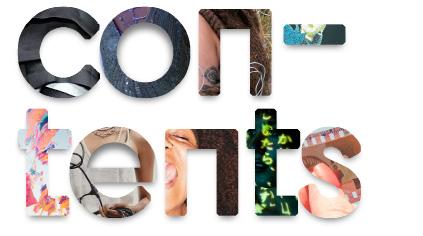
How K-pop is pushing technological boundaries.
They’re writing our essays, driving our cars and now buying our... shoes?
Creating radical self-love in the digital age by fighting the algorithm by being the algorithm.
Throwback to your old Hello Kitty flip phone.
EDITOR-IN-CHIEF
Molly Van Gorp
PRINT CREATIVE DIRECTOR
Ruth Ellen Berry
PRINT MANAGING EDITOR
Abigail Abdir
DESIGN EDITOR
Iliana Garner
DIGITAL MANAGING EDITOR
Alea Wilkins
SOCIAL MEDIA EDITOR
Paola Hernandez
MARKETING DIRECTOR
Anna Souter
STYLING DIRECTOR
Elias Xiwei Fan
FINANCE DIRECTOR
Nicole Feldman
EDITOR-IN-CHIEF
Carly Witteman
DIGITAL CREATIVE DIRECTOR
Ilise Angel
PRINT MANAGING EDITOR
Gabi Kurzer
DIGITAL MANAGING EDITOR
Lauren Cohn
DIGITAL MANAGING EDITOR
Austin Kim
MULTIMEDIA EDITOR
Ysa Quiballo
PHOTOSHOOT DIRECTOR
Chirag Bachani
STYLING DIRECTOR
Shelly Rood
CORPORATE DIRECTOR
Annika Srivastava
CORPORATE TEAM
Raya Bryant-Young, Allison Gould, Claire Wu, Julianna Tia, Laila-Aicha Adouim, Mia Jeremiah, Hamnah Malik, Mia Rhee, Adam Valiji, Diqiao Wang, Gabriella Burgos, Marlene Alanis
MARKETING TEAM
Ava Levinson, Julia Lehr, Ela Kopmaz, Grace Chang, Ismael Perez, Tess Berkowitz, Lalla-Aicha Adouim
DESIGN TEAM
Allie Wicks, Michelle Sheen, Sabrina Eicher, Zara Hasnani, Bettina Sánchez, Yasmin Mustefa
EDITORIAL TEAM
Audrey Clarendon, Alani Cox-Caceres, Catherine Duncan, Haben Fessehazion, Jade Garcia, Nyla Gilstrap, Augustus Glick, Isa Grau, Marija Jovic, Maya Krainc, Zuzu Maltarich, Allison Rauch, Elena Scott, Rahib Taher
MULTIMEDIA TEAM
Key Fils, Colleen Charchut, Emma Brown, Madison Morgan, Lianna Amoruso, Claire Wu, Anoushka Dasgupta, Jeremy Lee, Luna Xu, Branden Chen, Rose Kanaley, Sama Ben Amer, Emiliana Betancourt
PHOTOGRAPHY TEAM
Alessandra Esquivel, Devon Carlson, Joanne Haner, Julia Nichols, Melanie Ahn, Winnie Wang
SOCIAL MEDIA TEAM
Emma Sellin, Lexi Goldstein, Natalia Soro
STYLING TEAM
Anthony Barba-Perez, Camille Carey, Eloise Brotzman, Henry Winkelman, Maira Walker, Michael Mattews, Luluh Abathra, Olivia Heimann, Stacy Caeiro, Tosin Okoh
ANTHONY BARBA-PEREZ ONTARIO, CA

JUNIOR STYLING
"My favorite piece of tech when I was younger was my mom’s pink Motorola Razr! I always thought it looked so cool and it had a really fun game on it called flying toaster!"

MICHELLE SHEEN FULLERTON, CA
SOPHOMORE DESIGN
"My favorite piece of tech growing up would probably be my mom’s red slider phone from the early 2010s. When I was younger, I thought it was really neat that it came with a keyboard — like a portable computer!"

ALESSANDRA ESQUIVEL HOUSTON, TX JUNIOR PHOTOGRAPHY
"My favorite piece of tech would have to be the first camera I could call my own, and of course it was purple!"
ANOUSHKA DASGUPTA SCARSDALE, NY

SOPHOMORE
MULTIMEDIA
"My favorite piece of tech was my family’s iPad, where I’d watch wizards of waverly place (on YouTube, in 27 different parts) while eating my morning coco puffs."



Coperni’s dog robots and counterfeit Chanel in the metaverse are proof enough that fashion and technology are intertwined. As artificial intelligence overtakes many aspects of our lives, it begs the question: does technology do more harm than good? In STITCH’s Technology Issue, we consider this question through the lens of fashion. When does technocentrism stop being marvelous, and instead, turn menacing? After all, beneath a metallic bliss of iridescence lurks over surveillance, or even worse, a complete, AI takeover of pop culture as we know it. This duality frames the creative and editorial content.
Our photoshoots explore different fashion “futures:” over surveillance, glossy glitz, and AI-meets-real-life. Flashing cameras amid an eerie backdrop reveal a sinister side of technology. Yet, sequined dresses and iridescent makeup in the “Metallic shoot” remind us that the future can be something out of a dystopian novel or a Renaissance music video—sleek, shiny and carefree. And nothing says that AI and art can’t go hand-in-hand. The final photoshoot blurs the lines between editorial fashion and computer-generated art by transplanting models onto a DALL.E 2-generated background … Cher’s closet can step aside.
Our editorial content further confronts the digital dilemma. Personal essays evoke nostalgia for flip phones; Barbie and Disney Princess computer games; Polaroid cameras; and pre-Insta social life. But they also embody the thrive of securing the latest dunks with the help of a bot. Other pieces celebrate technocentrism for bringing us the cyberpunk aesthetics (i.e., dillo ‘23) and metaverse concerts.
Whether you see fashion’s merger with technology as fun or frightening, we hope you enjoy our take on this phenomena.

Virtual cityscapes; computers with human-like intellect; chips implanted in the mind, ready to digitize your thoughts and store them in the cloud – you can picture it if you’ve seen an episode of “Black Mirror” or an unblinking Mark Zuckerburg advertising the possibilities of your new life in the metaverse. The rapid pace at which technology is advancing has turned what once felt like futuristic daydreams into the new reality. It’s also increasingly reminiscent of the dystopias that science fiction writers and filmmakers imagined decades ago.
Creatives in the 1970s and 80s envisioned societies deteriorating as a result of unbridled consumption and creation of new technologies. This artistic movement – coined “cyberpunk” – came out of an increased awareness of Earth’s ecological limits and the extent to which humans were pushing it.
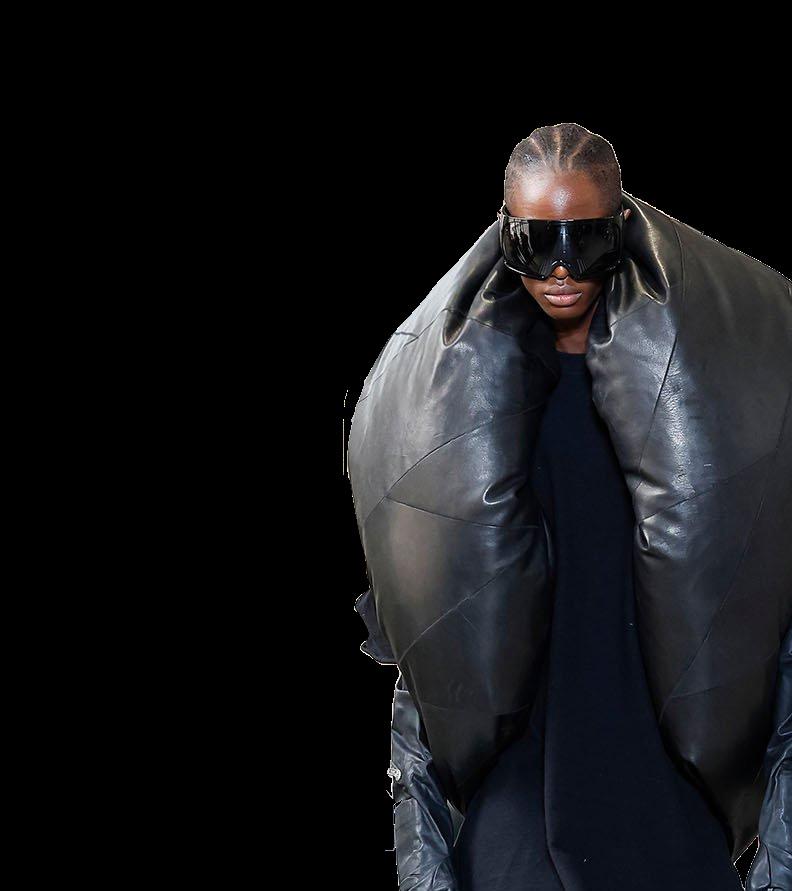
As Gerry Canavan and Kim Stanley Robinson explain in their book, “Green Planets: Ecology and Science Fiction,” cyberpunk explored the dark consequences of the “alternative scheme for getting outside this situation –simply leave the material world altogether by entering the computer.” In cyberpunk media, Earth is too small to accommodate humans’ insatiable appetite for technological innovation. And so the fragile, natural world is discarded for the digital one.
What began as a literary movement soon expanded to other mediums, such as film and the fashions it later inspired.
“Blade Runner,” based on Philip K. Dick’s 1968 novel “Do Androids Dream of Electric Sheep?” is one the most famous works of cyberpunk cinema. It is also one of the most frequently referenced in modern reinterpretations of cyberpunk fashion.
The costumes for Blade Runner are notably realistic, as is the film’s setting. The dystopian version of Los Angeles is vaguely familiar to the LA we know, only it’s darker, dirtier, colder and harder to live in. The large, layered and protective clothes reflect that environment and are completed with punkrock accents – big shoulder pads, fur, studs, top hats, and leather.

Cyberpunk influences appear in the work of contemporary designers, such as Belgian designer Raf Simons. Simons’ runway looks
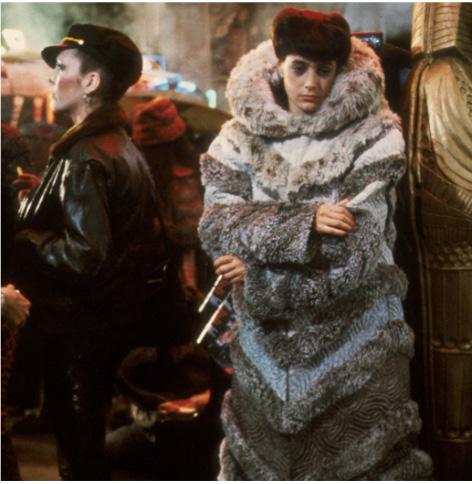 Blade Runner, 1982
Blade Runner, 1982
that make clothes look as though they were deconstructed and put together again. They almost seem to be made for a harsher environment, one that requires something more durable and protective to handle.

It’s in his 2018 Spring/Summer runway show that Blade Runner’s influence is most apparent. Guests stood as they lined the runway – a foggy street in Chinatown, lit by neon and slick with rainwater. Models walked in leather and metallic raincoats, plaid neck scarves and hats, and loose-fitting capris over rain boots.


Another designer who draws on cyberpunk is the fashion world’s “Lord of Darkness,” Rick Owens. “Futuristic,” “dystopian” and “grungy” are all words frequently used when describing Owens’ urban sportswear collections. The designs often have dramatic and asymmetrical proportions, morphing and distorting the body and blurring notions of gender. They are also nearly always in black, earning him his famous nickname.


The work of contemporary artists reflects cyberpunk’s unsurprising relevance in the present day. Artists of the cyberpunk
movement simply saw more clearly, and with more fantastical imagination, the trajectory of technological development that is being realized today. But as artists reckon with consumption and dystopia in the present day, they are doing so as a new school of thought emerges in parallel – one that responds to the question of where to go from here. Sustainable fashion might be the next phase to follow cyberpunk and propose a different possibility for the future. As awareness of the harms of massconsumerism heightens, the fashion world has increasingly seen sustainable fashion brands and designer labels gain popularity, along with trends that encourage thrifting, upcycling and doing more with less. In an essay discussing the climate crisis, philosopher Slavoj Žižek writes that we accept the harsh reality of our planet’s future, but that we might “against the background of this acceptance mobilize ourselves to perform the act that will change destiny itself.” If cyberpunk reflects an acceptance of where we’re going, sustainable fashion might be the
Metallics have always indicated a connection to the future and to technological innovation. In this photoshoot, we explore the aesthetics of metallics and how they intersect with fashion and beauty.
Creative Director: Ilise Angel
Styling Director: Shelly Rood
Kelner

Stylists: Anthony Barba Perez, Olivia Heimann, Maira Walker
Photographer: Joanne Haner
Models: Yashoswini
Chakraborty, Amaya Mikolic-Berrios, Jaida Hill
Design: Ruth Ellen Berry
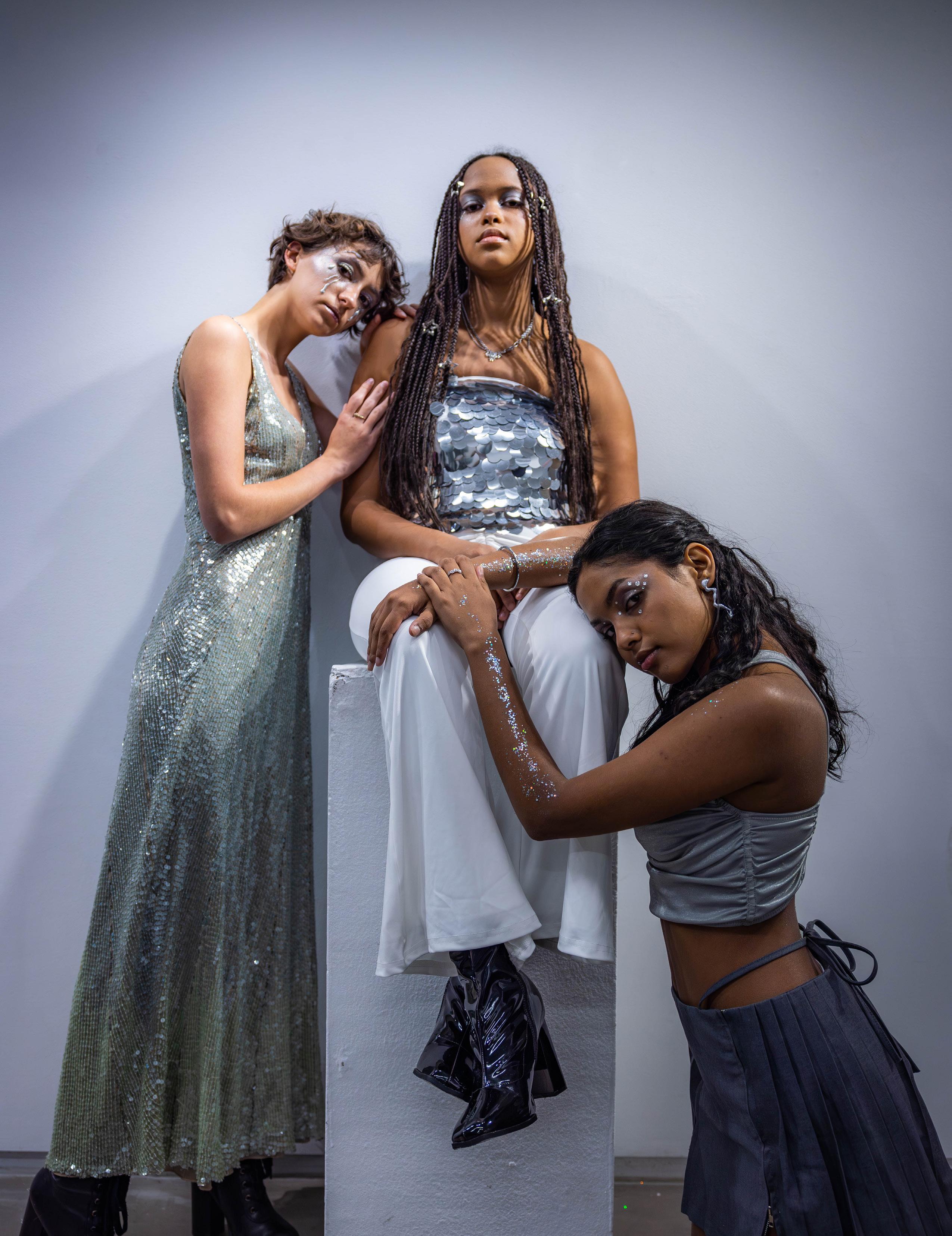



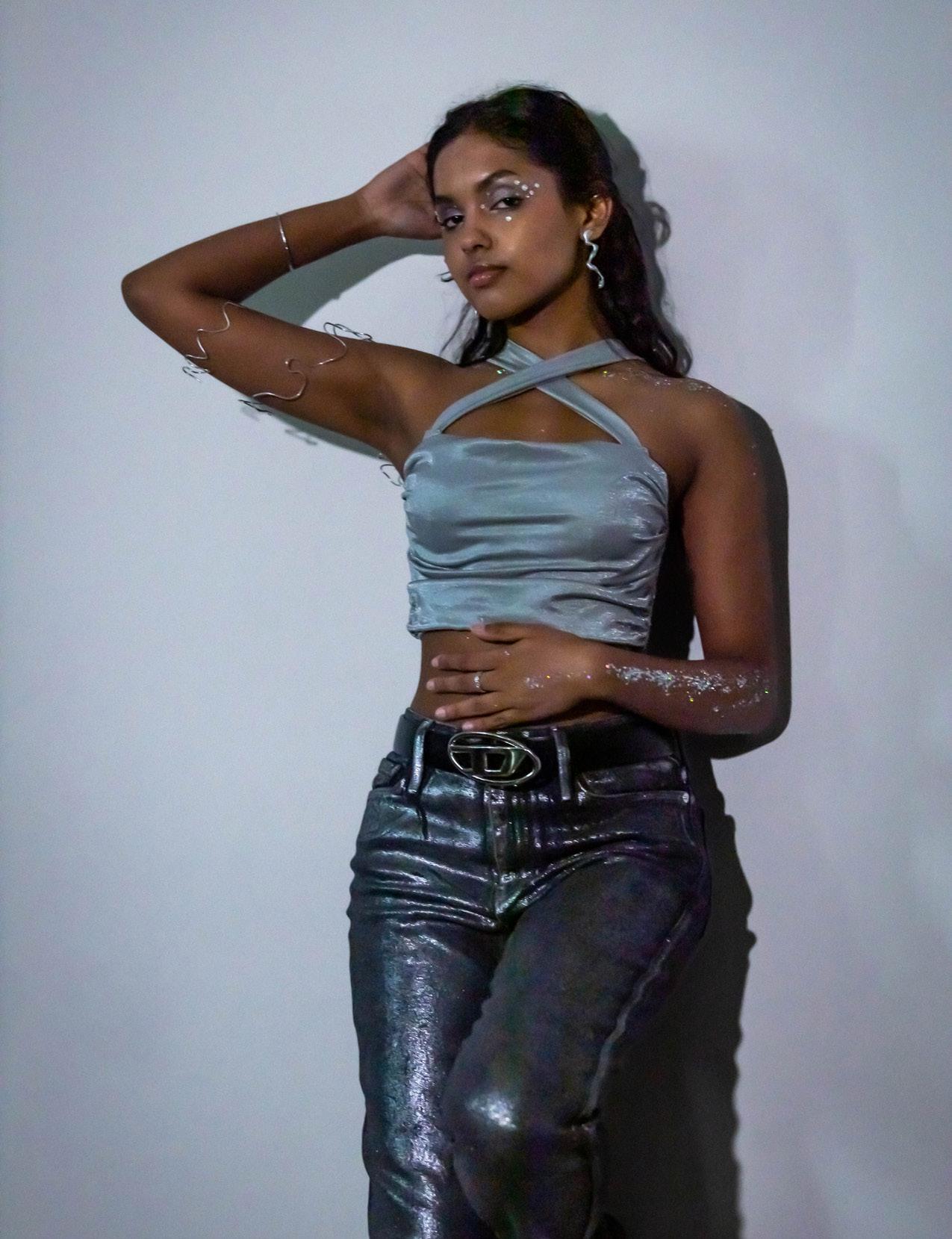


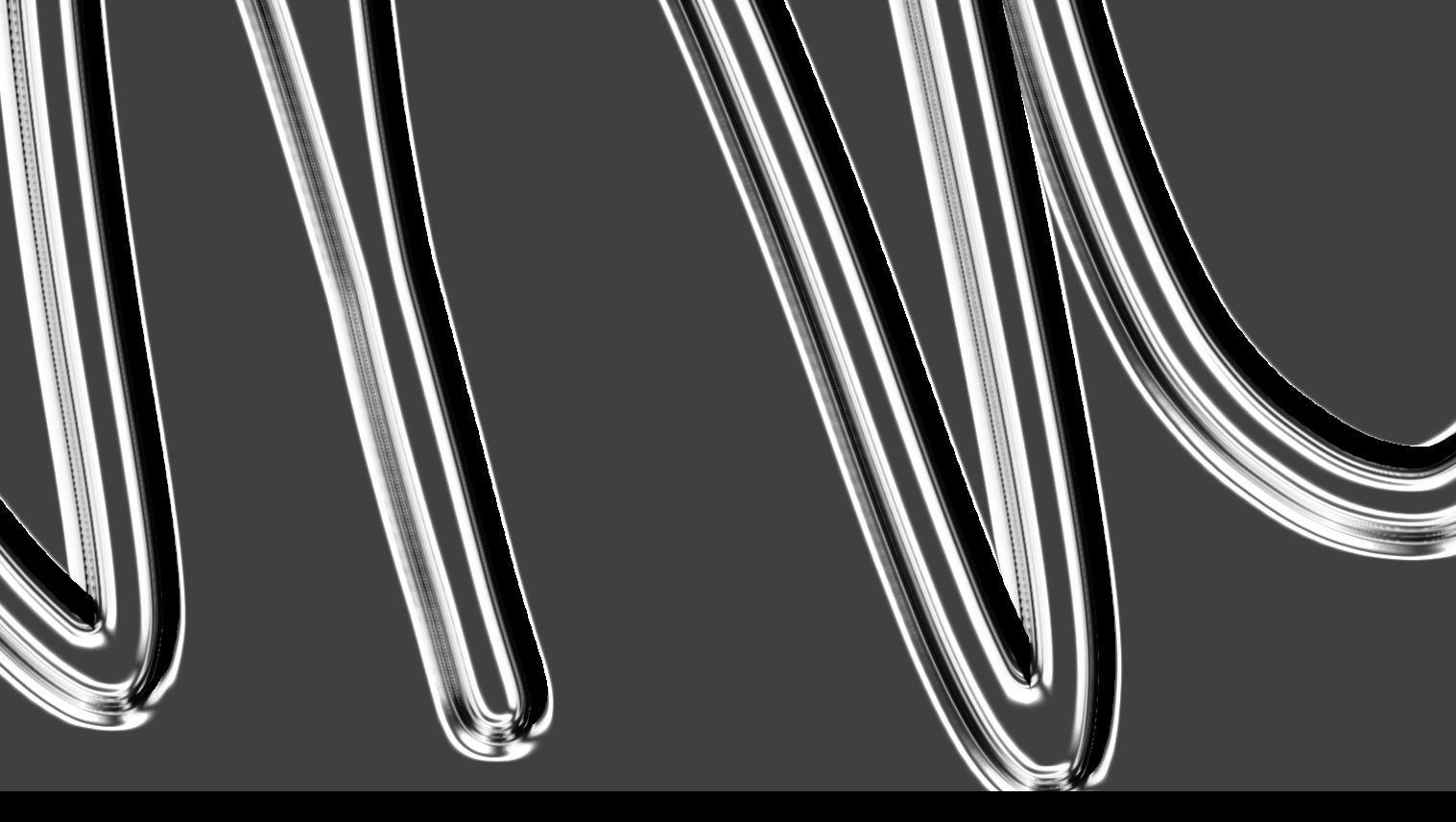
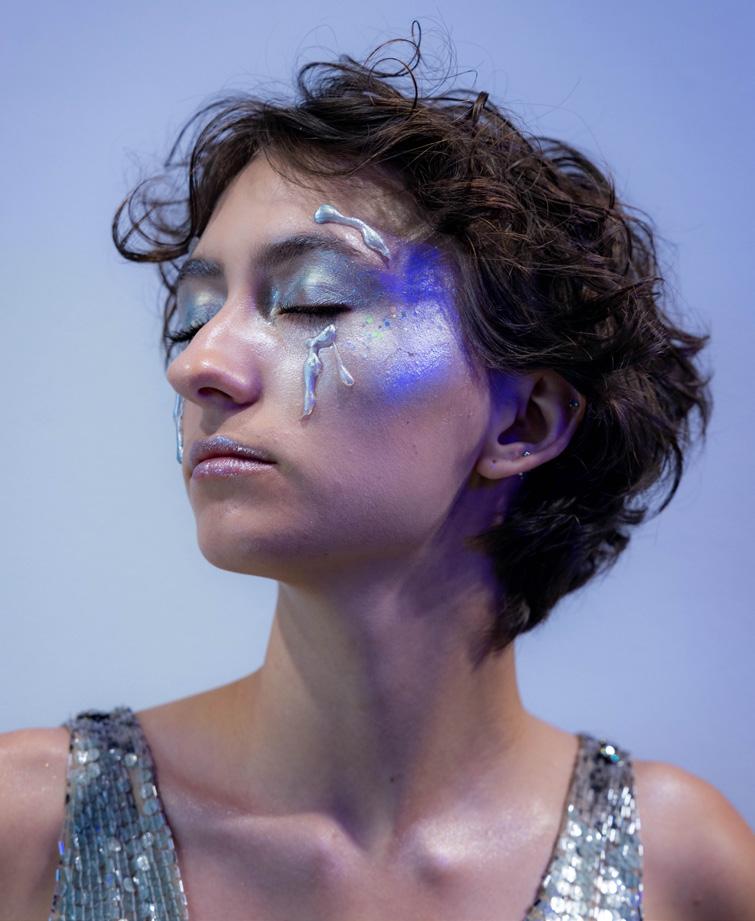



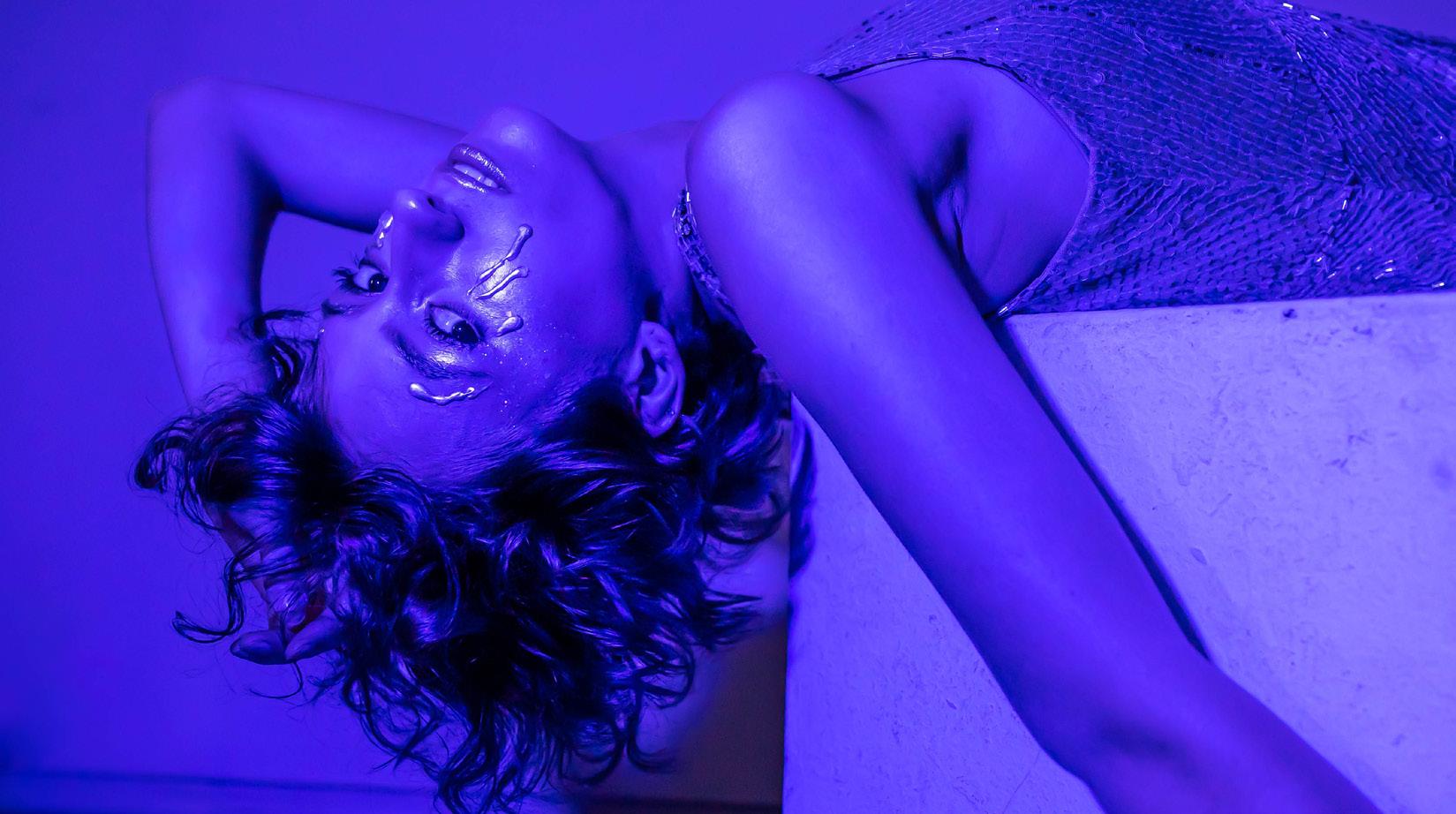



Marc Jacobs. Sandy Liang. Valentino. Gucci. Ted Baker. What do all of these brands have in common? You can make your Animal Crossing character absolutely dressed to the nines in all of them.
Designed by Iliana Garner


Fashion’s influence in video games has grown from simple character options to fully-fledged marketing schemes and digital integrations. As high fashion brands pixelate their products into virtual assets, the fashion industry is seeping into seemingly untouched terrain. But for those who have grown up matching their Club Penguin’s outfit to the color of their puffles, admiring their customized Miis bouncing around the hypnotizingly sterile Wii waiting room or curating their Sim’s look for hours (and not in custom Moschino, which apparently is available now), the confluence of fashion and video games is nothing new. I asked Northwestern students about their experience balancing their virtual fashion with their reality.

I was really into GirlsGoGames.com— the classic dress-up flash games, where you choose from a bunch of makeover games. GirlsGoGames games gave me a bigger sense of: “Oh, [fashion] is something I can pay attention to.” It was always pretty clear, like, the sorts of things that go together. I would [also] force all of my friends to play Fire Boy Water Girl with me. My best friend and I had done all the levels until they were 100% perfect. I honestly think that in a broader sense, [those games] being more colorful and fantasy-like, but lighthearted fantasy, influenced the way that I handle clothes. The way that I think about clothes now is: it's how I play as an adult. Dressing up in the morning or dressing up for an event is [like] an adult playing around. And so, I think the fact that these video games were whimsical probably impacted the dress and still impacts the way I dress. I really like to thrift super impractical, but funky and special pieces. Like, I have no business wearing these clothes every day and they will just fit in my closet until the perfect moment arises, but it's so fun for me to have them and have this unlimited style even if it's just gonna be in my room.


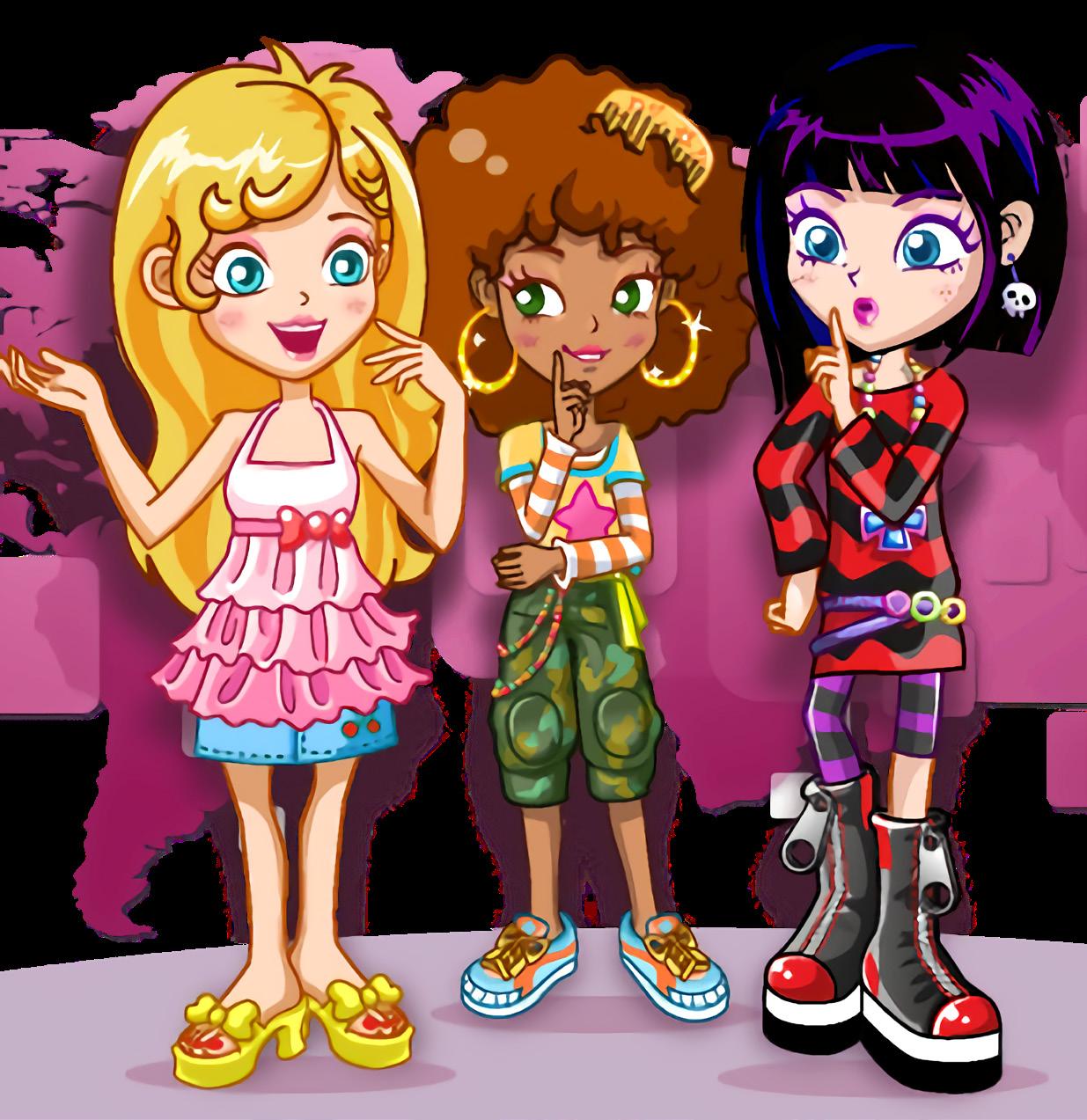
I think that the way you interact with video games and which ones you interact with have the capacity to shape your creativity. And your creativity has a huge impact on your fashion. Yeah, there's clear ways where maybe you dress your characters like yourself, but in a much broader sense, the amount of creativity you're using in these games, I think relates to how much creativity you're using in your fashion. And, not to stereotype, but we do see a gender difference in fashion. Maybe that's harder is that like a lot of typical “girl” games growing up are creative and colorful and a lot of “boy” games are strategy and fighting based. And what we're really doing is limiting male creativity, which flows out into other aspects, one of which is fashion, which is the most obvious.

The second game I ever played online was a Disney princess video game where you could customize your own princess avatar and have yourself in the game. That's the first time I'd ever experienced that sort of relatability to the main character because you were the main character. When I get to customize my character, I usually try to make them look like me, like a literal selfinsert moment.
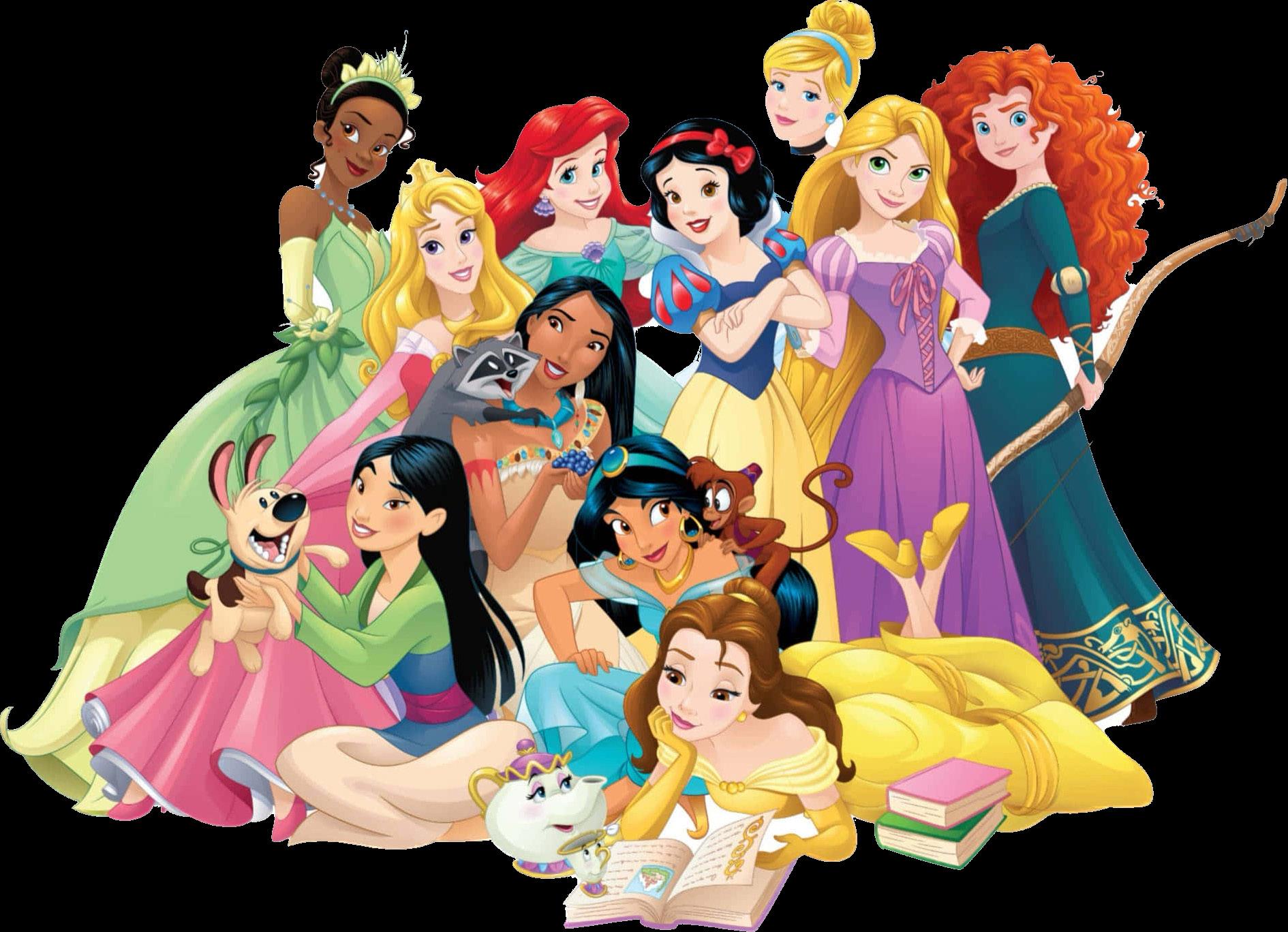
I always played Girls Go Games, specifically the flash game where you dress up this random person, and I remember envisioning, like: this is how I think they would go to school, this is how they would go to a fancy dinner. Even though the game itself was just a dress up game, I would envision whole storylines based off of the outfits I would create for that character. If I have the option to go a step further and choose the smaller details of that larger theme, then I think that definitely goes back to my own personal preferences for colors and my personality.
The virtual space is sort of like a playground for your fashion choices. It can help lead you into new directions on how you want to express yourself later on. It's not just a one-way sort of influence, just you influencing the character. It's the character influencing you as well.

The first character I remember customizing fully was in the Build-A-Bear online game. Oh my god, you know where you got to build a bear, and then you could upload it. I made them look like me, or as close as I could. When I was younger, I was more concerned about what my character looked like. But I think as I've gotten older, I've paid more attention to my characters, and I tweak them a lot more based on what game I'm playing, like Cyberpunk 2077, for instance.
Videogames [give you] that sort of ability to experiment. You know, not just with clothes, but also gender expression and stuff like that. It's not just experiencing the world of any given video game or the gameplay, but [it’s] also what you get to be in that game. I really love the options in Cyberpunk 2077. It’s got hairstyles, skin, clothes. It has everything you could want. Which is nice because if you want to be a certain person, it really gives you the latitude to do that.
Video games provide you the opportunity to experience these stories that you couldn't otherwise through the lens of some other person. And I think clothing is just one element of that—the level of expression in modern games is insane.



I played a lot of Tony Hawk's Pro Skater and Minecraft as a kid. I would honestly say that my personal fashion sense influenced the game more than the game influenced my fashion. I tried to dress the character up as closely as I dress in real life. It’s a low stakes form of experimentation. It doesn't cost anything to get started [and] dress up your character. Also, if it looks kind of bad, nobody really cares. You can try out a bunch of different stuff, and maybe find something that suits you in real life. And when you put on something that has a reference to a video game, people sometimes come up to you and talk to you about it. Then you make friends with people that you wouldn't have made friends with.

I could definitely see cyberpunk influencing some fashion trends as well—through Blade Runner 2049 and games like Cyberpunk 2077, they really revived the genre. So what you get with that is the cascading effect of people picking up the aesthetic again. I'm sure you could see people wearing things from [those] game[s], even if it's indirect. There’s [also] this trend of people dressing up like Y2K: baggy cargos and skinny tops and stuff. I think it's [partially?] inspired by Jet Set Radio, which is this really old Sega game where you're on roller skates [and] doing graffiti, but it's so stylish and so cool. The characters have such cool designs that it's so easy to take fashion inspiration from that.


The fashion industry is known for contributing massive amounts of waste into the environment and unsustainable manufacturing processes. In this shoot, we examine how, even in a world reliant on technology, we are still grounded and connected to the Earth and natural world that surrounds us.

Creative Director: Ilise Angel
Styling Director: Elias Xiwei Fan
Stylists: Anthony Barba-Perez, Henry Winkelman
Photographer: Devon Carlson
Models: Sara Azimipour

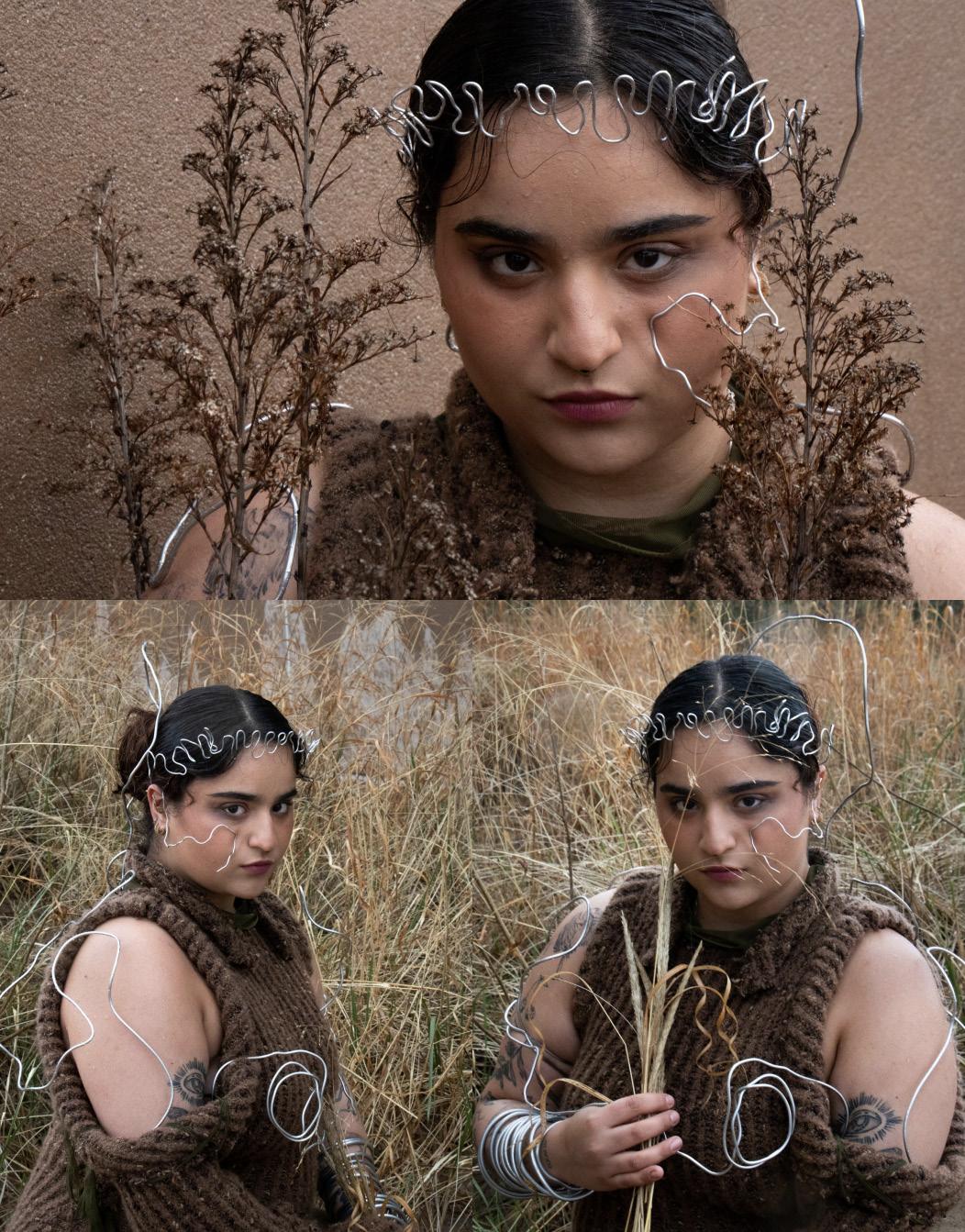




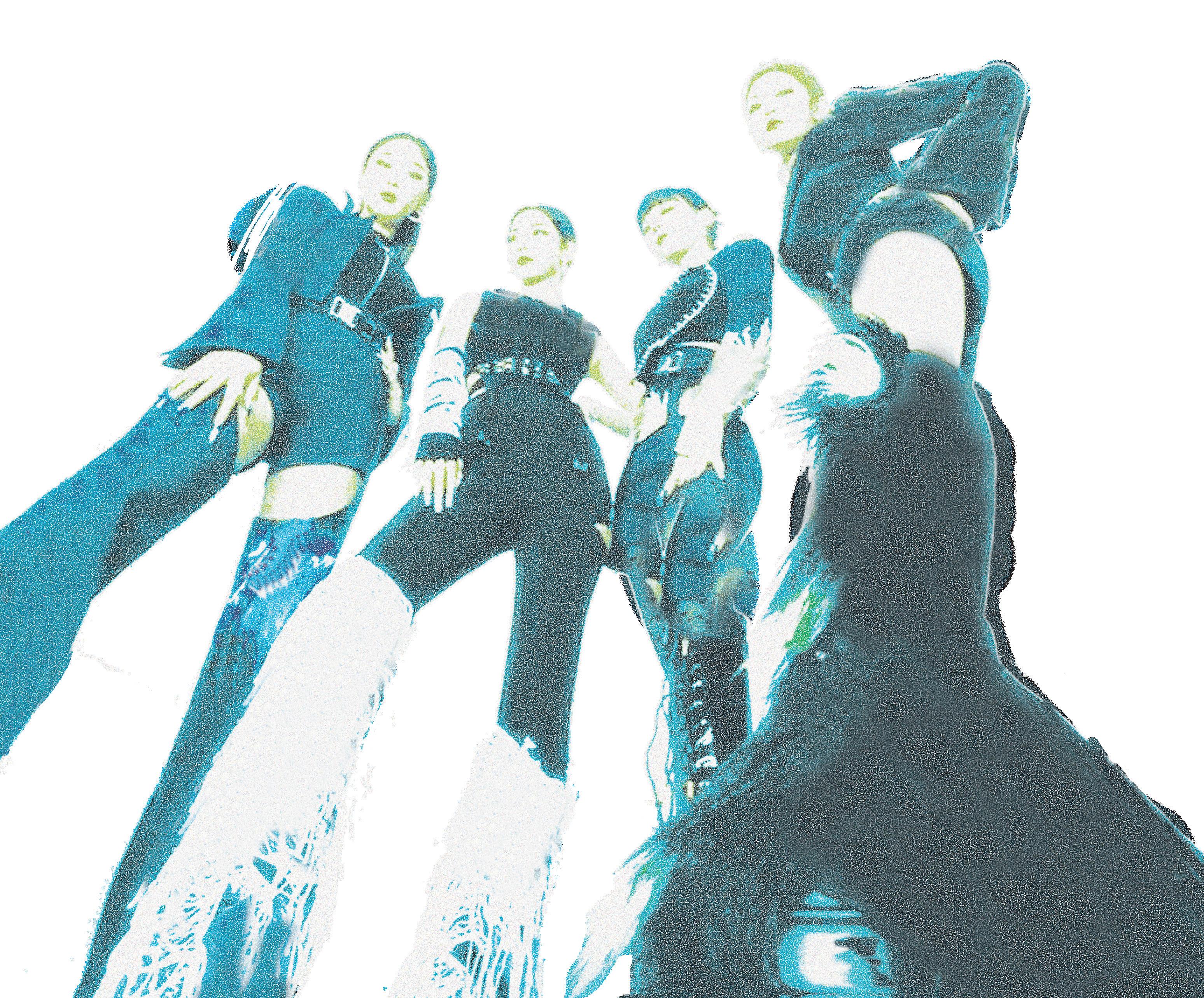
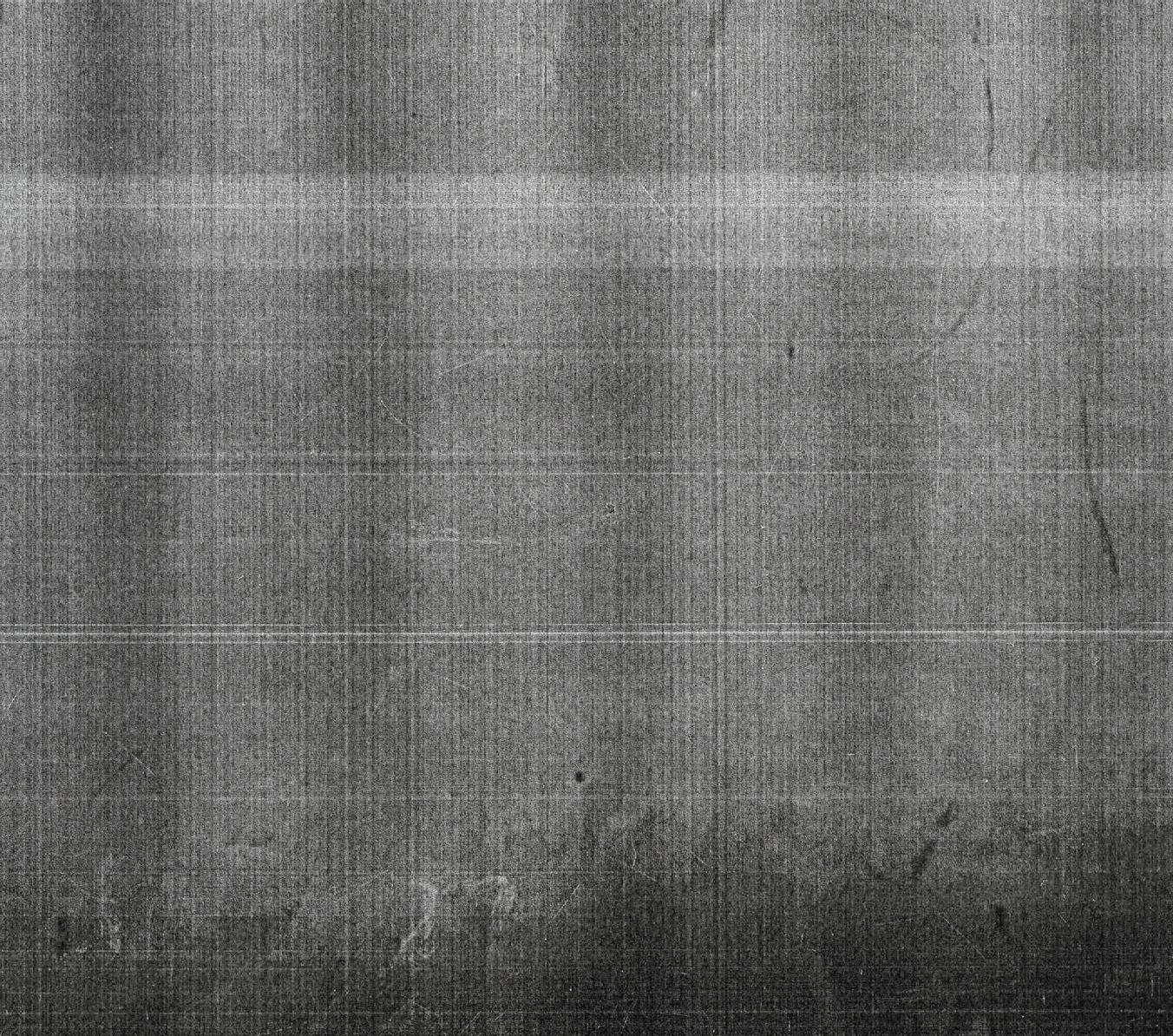


They’re writing our essays, driving our cars and now they're buying our… shoes?
Hunching over your computer’s digital clock as the seconds tick upward, your sweaty finger hovers readily above the trackpad. The hairs on your neck straighten and tingle with excitement, time moves slowly, and your impatience climaxes. As the second-hand shifts from 59 to 00 and a quick page refresh reveals your desired footwear,
By Augustus Glick Designed by Iliana Garneryou delay. Not because you questioned the purchase, not because Mom said the pizza rolls were done, but because you are human. Without doing anything wrong, you lie inactive for .25 seconds. And within that quarter of a second, you don’t click any buttons or fill out any necessary item lines, not to mention the strenuous 16 digits on your credit card and its accompanying doom date.
And now, they’re gone. A glaring SOLD OUT stares back at you from the shallowness of your screen and your almost-purchase sits on a resale website for double its original retail value. But how could it be? You ask yourself, hopelessly staring into the black mirror that is your now resting device. Did Erik Treiker (aka Shaz), the 2022 fastest typer in the world, outpace you? No. You got bested by a sneaker bot.
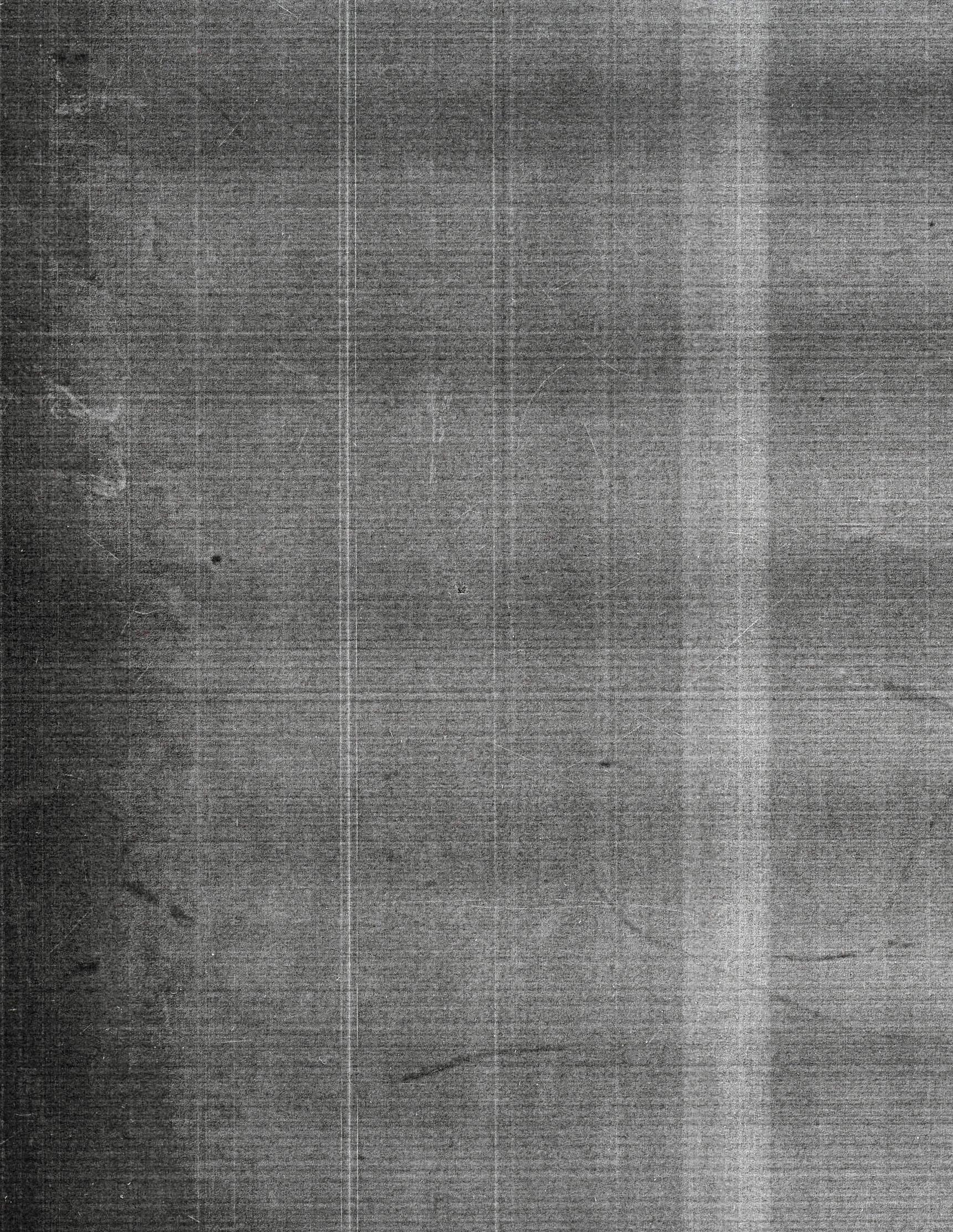
A sneaker bot, like the Wrath AIO Bot, is a computer program intended to do the exact work a dedicated reseller would do, just much faster and in much larger volumes. These bots can sweep online stock and sales information, enter raffles in quantity, auto-purchase, and even predict URLs and drop times to get ahead of the public rush. In essence, they run circles around their human competition and have reset the standards for what is needed to buy low-supply, high-demand fashion.

For all the reasons these purchasing bots have overwhelmed the online shopping market, the most significant advantage is their unchallengeable dedication. If you’ve gotten this far in reading this article, I’d deduce that you generally have a higher tolerance for low-intensity activities, but, to put it bluntly, all of us humans have sh*t to do. Unlike the singularly-purposed life of computer software, we don’t have the capacity to sit nonstop at a website waiting and refreshing, waiting and refreshing. Statistically, they’re just more likely to catch something than we are.
However, many of these bots don't sit dormant. While they wait for their regularly scheduled jobs, some have been taught to simultaneously search for other new and undiscovered opportunities. Trial-and-error testing for unannounced but live URLs, these bots can find the precoded websites of new products, purchasing them
even before the company itself is prepared to sell. This type of bot has caused numerous product exploitations, suspensions, and even cancellations, like the Strangelove Skateboard x Nike SB Dunk Low Collab.
The most common sneaker bot is the scalper. These types of bots make Shaz look like a 10-hour drying paint documentary. Faster than we can react, .2 seconds versus our pathetic little .25 seconds, the scalper bot tosses your dream sock-protectors into the cart and, after filling out all your information instantaneously, clicks buy before you can even start.

Though this phenomenon currently only resides within a majority of high-demand brands with a drop-based approach to sales, it isn’t unreasonable to question if this is the future of online shopping. Would you rather stay true to buying naturally and losing or succumbing to the code and rocking the hottest of kicks? Though the committed moralist would vouch for the prior, the fact remains that without a bot, there is no competition. The playing field is as unequal as it has ever been, and there seems to be no concrete solution to bring it back to the good old-fashioned chance of the draw.
In a global market of nearly $10 billion, the complexity and utility of this software is becoming an increasingly hot commodity, much to the chagrin of human-dependent buyers and sellers. Though companies try their best to spot purchase-bots and void their orders, it's undeniable that many bot-controlled orders slip through the cracks and beat the homo-sapien to the shoe. With a new standard of online purchasing speed and efficiency, it seems that yes, we humans are losing our fresh pumps to R2D2.
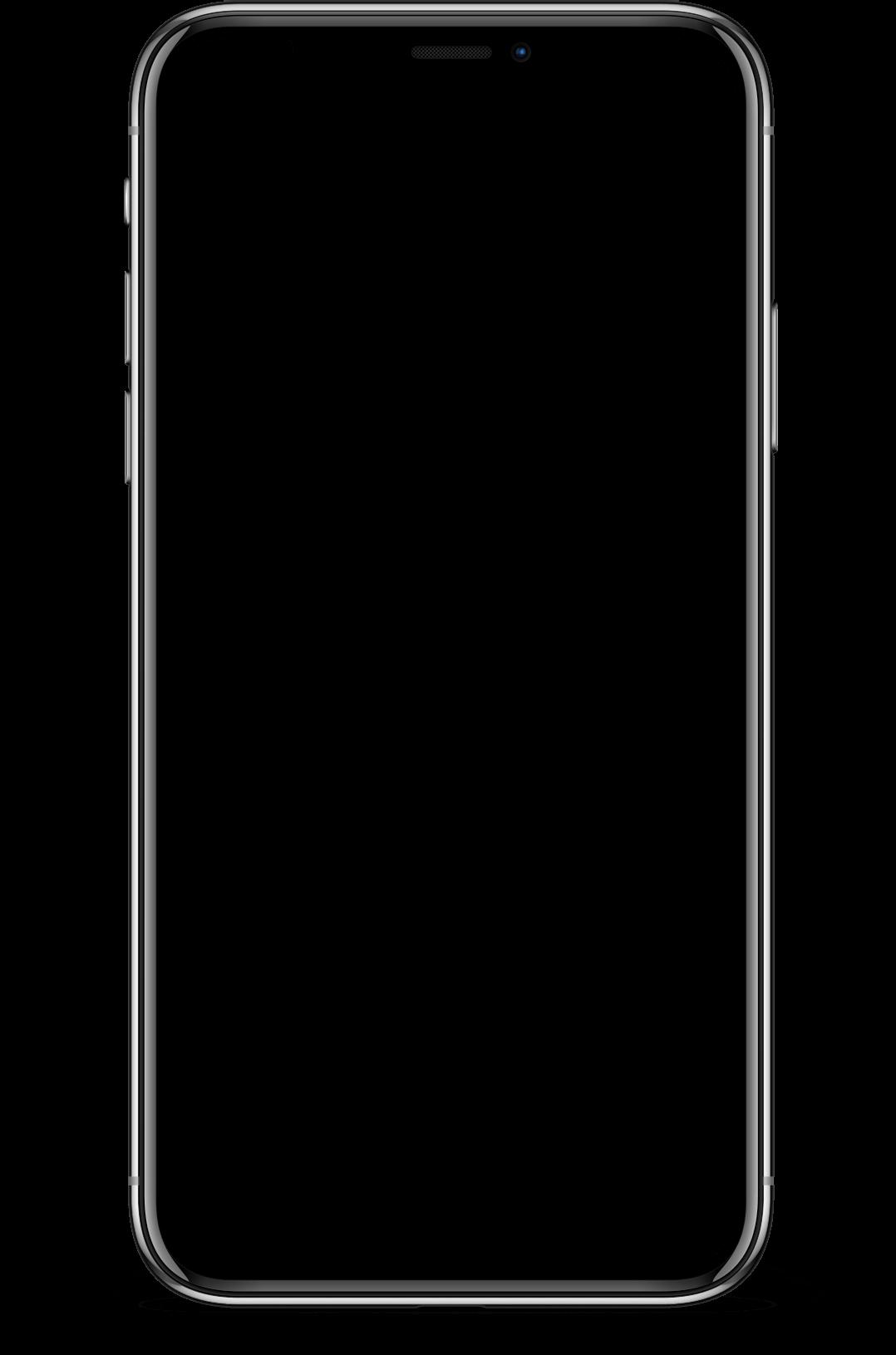


Step into the captivating world of AI, a venue that transcends the boundaries of time and space. In this extraordinary visual journey, fashion merges seamlessly with cutting-edge artificial intelligence, whisking us away to a realm where technology and style intertwine. Follow as the models traverse virtual landscapes both inspired by and created with the assistance of AI algorithms Chat GPT and DALL-E 2. From disco bubbles to dystopian movie sets, each photograph unveils a new dimension of fashion's possibilities, where data-driven artistry and innovation seamlessly blend to redefine the concept of couture. Witness the birth of a new aesthetic paradigm as this photoshoot showcases the limitless potential of AI's transformative influence on the world of fashion.
Creative Director: Ruth Ellen Berry
Styling Directors: Shelly Rood Kelner and Xiwei Fan
Stylists: Anthony Barba-Perez and Eloise Brotzman
Photographer: Alessandra Esquivel
Models: Adrienne Scheide, Beza, Yamini Ulaganathan, and Beza Abate
Design: Ruth Ellen Berry











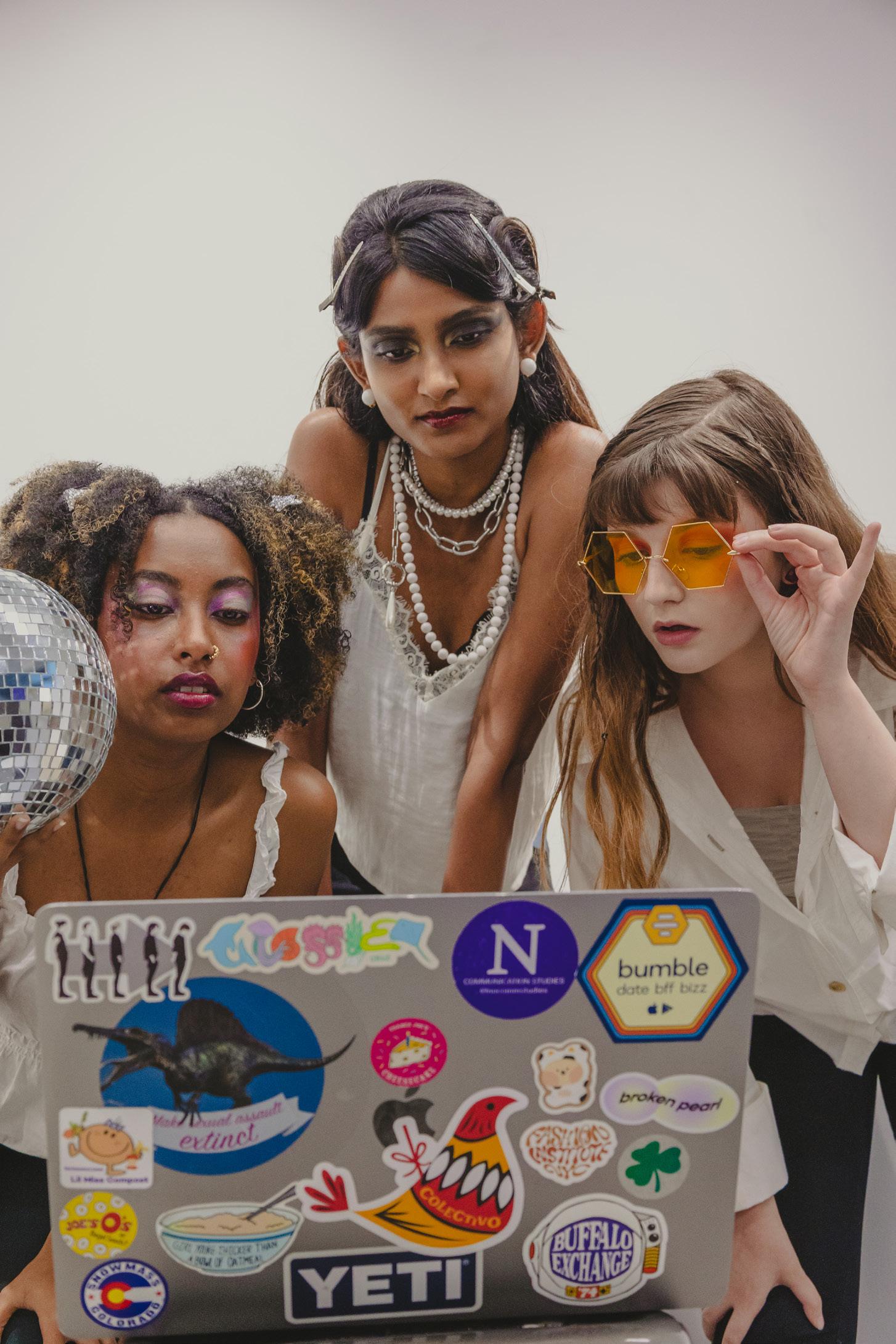


Let me take you back. It’s late 2012, maybe early 2013. I’m about 11 years old—you’re probably around the same. The fourth and fifth grade common rooms are abuzz. It seems as if everyone is trading in their iPod touch for the iPhone. I was one of the first people in my grade to cop an iPhone 5 after Apple’s momentous reveal of a slimmer phone with a better camera and a new charging port. My mom was hesitant to get me such an advanced piece of technology so young. If only she and I had known what was about to be set in motion, and how long the effects would last.

The social clout I got from my new phone was immediate. People crowded around me to see my phone, strapped with the novel LTE wireless range. Suddenly, the times of playing Temple Run and Sims Freeplay were a thing of the past. It was around this time I downloaded Instagram, eager to establish myself as a “hot girl,” one worthy of being crushed on and talked about.
By

 chiarad0rsi STITCH Magazine
chiarad0rsi STITCH Magazine
364 Likes
chiarad0rsi Check me out!

Creating radical self-love in the digital age by fighting the algorithm by being the algorithm.
Chiara Dorsi // Designed by Yasmin Mustefa & Iliana Garner
From a very young age, technology perverted my selfconcept and self-presentation. In elementary and middle school, Instagram was where kids became cool. It felt like all eyes were turned on what people were doing each weekend and who they were with. Almost immediately, I felt bombarded by the numbers and names on Instagram: I was counting likes, comments and follow-backs; downloading apps to add cool filters and edits to my photos; even going as far as to buy likes or use the hashtag “like for like back.” I was obsessed but pathetically misguided. I don’t have to tell you how easy it is to associate your self-worth with the statistics you see on your account compared to other people’s. Quickly, a pecking order emerged between the girls who used Instagram successfully— weekend photoshoots showing off their fro-yo cups, the Hermés bracelets they got for their birthday, their Lululemon outfit at SoulCycle— and me, a pudgy, awkward-looking, hadn’t-yet-grown-into-themself middle schooler. I wasn’t wealthy, white or thin enough to flaunt what no one wanted.om my phone and confronted the being I saw in the mirror:
Her face is uneven. One eyelid droops lower than the other.
Her nose is wide. It seems to take up her entire face.
Her hair is frizzy and unruly
beyond belief. Unkempt, uncontrolled.
Pudge peeks out over the waistband of her jeans.

To an impressionable, young girl, the images and messages I consumed online were very clear about what was deemed attractive.
And the reflection I saw looking back at me was not reaching those standards.
But none of this narrative is to say people who do align with the beauty standard can’t experience insecurity either. Our social media is constructed in such a way that convinces all of us, from any and all backgrounds, that we’re not good enough, not hot enough, not beautiful enough. For some of us though, we don’t just battle internal dysmorphia–we have to contend with centuries of systematic racism and fatphobia perverting our beauty standards.
At first, I tried to fit in. Over the years, I tried so many things at different times and to different amounts of success. I straightened my hair—–the response was favorable, much more so than when my hair was curly. Boys commented on it: “You look so much …better?” or something along those lines. I lost weight. Again, people noticed. I even went so far as buying stupid Amazon nose pinchers to slim my nose. I poured honey and lemon juice into my eyes in hopes I would wake
up in the morning with blue orbs looking back at me.
But these attempts all fizzled out eventually: I stopped trying to change myself. I wasn’t happy. I couldn’t be happy so long as I was forcibly going against my DNA, my culture and my origins to fit in a mold of “the hot girl” that would simply never reflect me.
I cried. I screamed at my mother. I cursed her name. I cursed her for giving me dark skin, a wide nose, curly hair and a body that holds its weight in the thighs and stomach.
And then I screamed at myself for hating every last little thing about me. For hating the DNA that made me who I was. I screamed at myself for deciding my selfworth was based on something as superficial as being wanted. And then I screamed at the world, at the algorithms, at society, at colorism, at thinspo hashtags, at Tumblr anorexia blogs, at People Magazine, at white-washing, at the boxes of curly-hair relaxers at the CVS. I screamed at them for making me hate myself and making me feel the need to change who I was to be loved, to be admired and adored.
But screaming and anger only last so long. The bubbling emotions eventually dissipated. I was tired of caring, so I stopped trying entirely. The curly hair came back, the weight came back, the nose pinchers were thrown out and the pathetic
Her face is uneven. One eyelid droops lower than the other.

Her nose is wide. It seems to take up her entire face. Pudge

peeks out over the waistband of her jeans.
Her hair is frizzy and unruly beyond belief.
Unkempt, uncontrolled.
mirror. I taped up my bedroom mirror so I wouldn’t have to look, I kept my eyes down when in public bathrooms, and I stayed off Instagram.

I wasn’t born into a body that would wholly let me fit in, so there was no point in trying—hookup culture and romance simply were not for me. I focused on other
unorthodox for our generation. My phone, however, was full of photos and videos: of myself, memories from my life, pictures of good meals, mirror selfies, cute outfits I liked. They simply



when I shared my pictures and saw others that I felt Judgment Day would come.
Eventually, I got bored of my storage piling up with photos no one would ever see. So I dipped my toe back into the Instagram world. I made a second account with a pseudonym, only following the closest of my closest friends. Little by little, I started sharing snippets from my life. The sunset from my roof. A new tattoo. A cute dog on the street. A nice sushi dinner. My body. My face. My hair.
The photos barely had likes or comments, but I liked watching the account grow. I was building a digital diary of moments from my life, creating space for myself in a little corner of the Internet where I could exist as myself.
In the first four months of having the account, I had 100 posts. I still had zero on my main Instagram account.
It was the end of freshman year when I finally gathered the courage to restart my main account. Our first year in college, for the Class of 2024, was the furthest thing from
“And then I screamed at the world, at the algorithms, at society, at colorism, at thinspo hashtags, at Tumblr anorexia, at People Magazine, at white-washing, at the boxes of curlyhair relaxers at the CVS."
normal we would’ve expected growing up due to the pandemic. But as I started to feel settled, started to find and make friends that I now love, trust and cherish, I wanted to feel seen again, to be known. To stop hiding in the shadows of an account with no posts and few followers. Whether I liked it or not, Instagram was gonna be a presence in our lives, with or without me. I felt it was time for me to have a public online presence again, not just a hidden one.
On June 4th, 2021, I posted my first photo (since middle school) to Instagram, to about 1000 followers who likely forgot they followed me in the first place. And it felt really fucking good. And then I posted again, and again, and



again and it kept feeling good. Say what you want about the thinly veiled superficiality of Instagram comments, but external validation can really do the trick sometimes.
As I kept posting, I found myself caring less and less about each photo that I uploaded. Sure, maybe my teeth were crooked in one pic, or you could clearly see my stomach rolls in a bikini photo. I had already learned that trying to change myself was an erroneous and dangerous attempt to align with a beauty standard simply not made for me. But that didn’t mean I couldn’t make space for myself on the platform. I gained confidence in knowing that every photo I put out there brought a new meaning to the word “beauty.”
Beauty could be frizzy hair, and cellulite, and wide noses and love handles. Beauty could be anything I wanted it to be because that’s how I was made, and nothing was going to change that. I deserve to exist in the real world and in the digital space as I am. I deserve the power to change what and who we consider beautiful. By choosing

“ I gained CONFIDENCE in knowing that every PHOTO I put out there brought a new MEANING to the word BEAUTY."
to do nothing, to post nothing, it’s almost as if I reinforce the beauty standards that I hate so much. Maybe this is more a story about how much middle school sucks and perhaps the poor timing that Instagram had to drop before I hit puberty, when I was jacked up on hormones and first period horror stories and DIY haircuts. But being 21 years old doesn’t mean I feel like this fight is over. There are still days I wake up and want to shatter my mirror, when I want to straighten my hair to a crisp or put myself into debt with a nose job. Some lessons take years to unlearn; sometimes I doubt I’ll ever unlearn the mystique of the thin, white beauty standard. But it feels a lot better to keep trying. So each day I choose to make the algorithm a little blacker, a little curlier, and a little more chubby. I flaunt and exhibit myself as I am. I radically reclaim what it means to exist, to be worthy of love. And that counts for something. We say who and what the algorithm is. And that’s a win in my book.

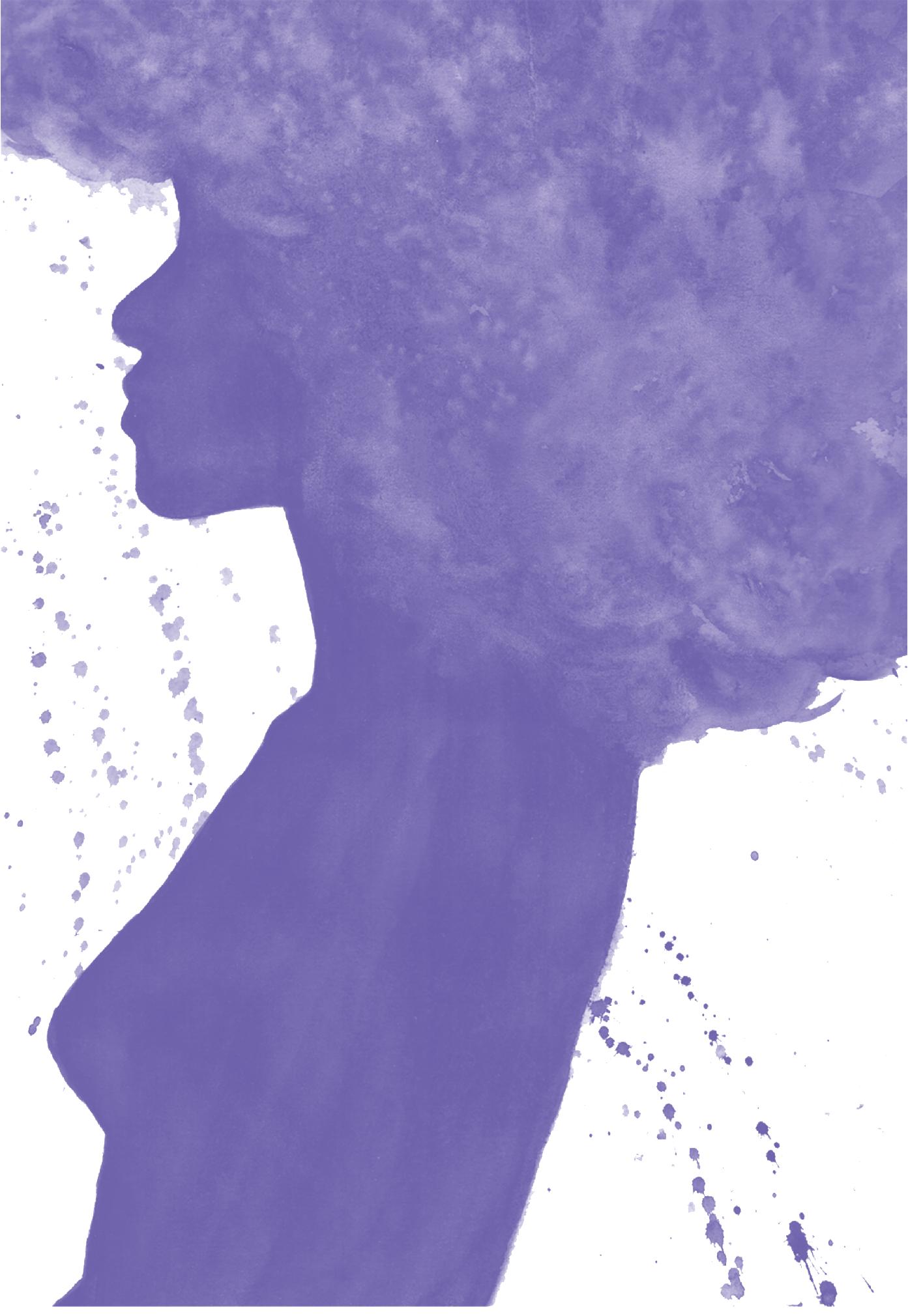
“So each day I choose to make the algorithm a little blacker, a little curlier, and a little more chubby. I flaunt and exhibit myself as I am."
Photographer: Julia Reese Nichols
Creative Director: Ilise Angel
Styling Directors: Elias Xiwei Fan, Shelly Rood
Kelner
Stylists: Tosin Okoh
Photographer: Julia Reese Nichols

Models: Alex Sudmann
Designed by Michelle Sheen
Creative Director: Ilise Angel
Styling Directors: Elias Xiwei Fan, Shelly Rood Kelner
Stylists: Tosin Okoh
Models: Alex Sudmann

In this digital age, it can feel like our lives are constantly under surveillance and without any right to privacy. We imagine a future where our lives are constantly on display and the line between the ‘watcher’ and ‘subject’ is increasingly blurred.
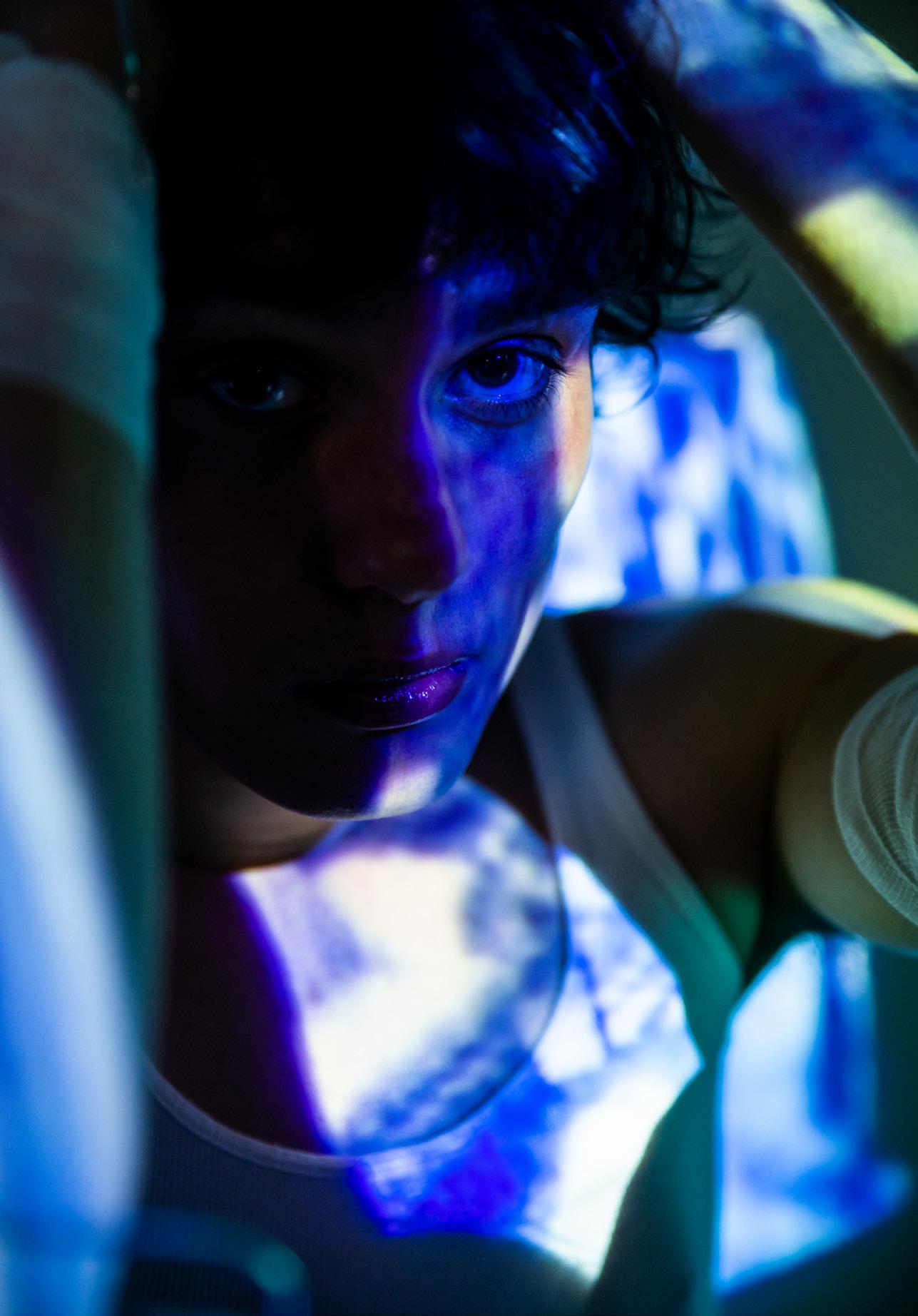






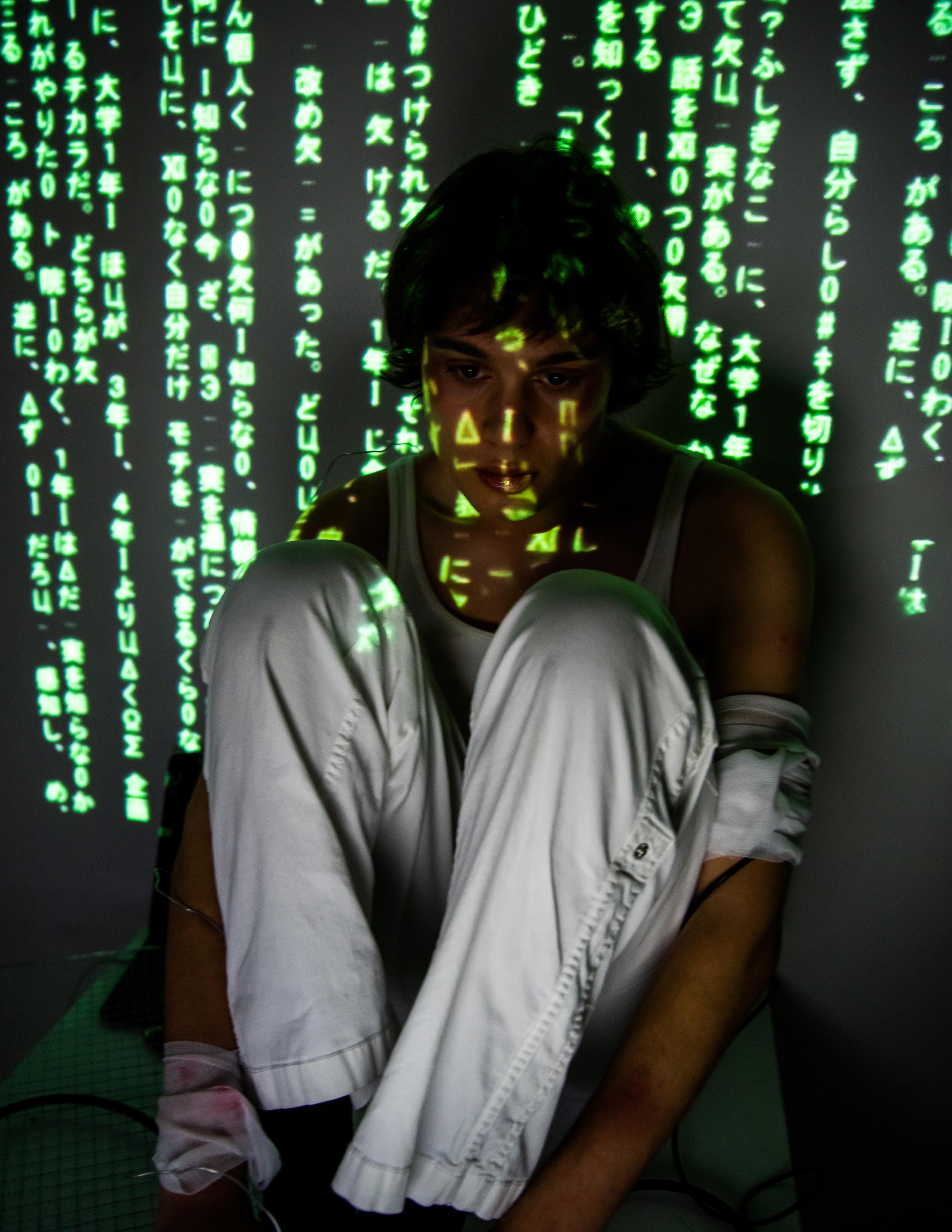
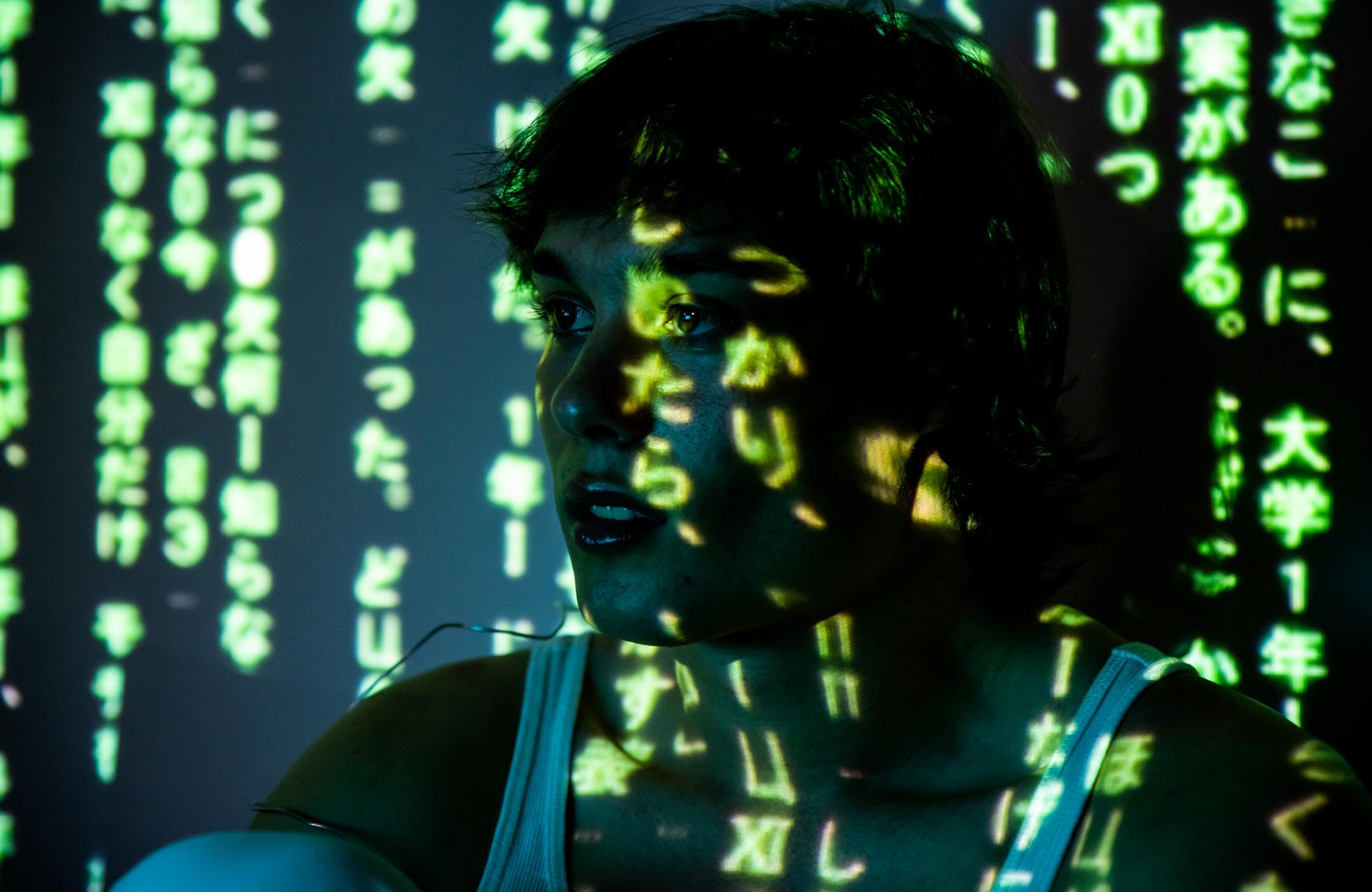








The other day I received a frantically worded text from my sister asking if I remembered the old Barbie mermaid game we used to play on the computer as kids. It was a DVD we’d load into the disk drive and take turns controlling the mouse while the other hovered over the keyboard, waiting for her turn to play. I scoured the internet for remnants of the game and soon, a deep, unsettling sadness registered as I came up with nothing more than low-quality photos of the DVD case on Google Images.

My sister’s urge to play our old Barbie video game, the way I love sifting through used vinyls at the second-hand store to listen to on my grandparents’ old record player, the reason why so many people take their film camera on vacation rather than use their iPhone’s impressive quality: they’re all symptoms of tech nostalgia, the
longing to return to outdated technologies to emulate and relive past experiences, even ones we may not have been alive for.
In 2001, Polaroid filed for bankruptcy. Now, the brand’s renewed prominence has solidified the cameras as a classic example of the joy of physical photographs over phone pictures. In 2021, vinyl sales skyrocketed according to MRC Data, having the first week in history to see sales over 2 million and outpacing CD sales for the first time since 1991. The hashtag #flipphone currently has over 700 million views on TikTok. There’s clearly a demand for retro tech, one that goes deeper than just basic trend cycles that come and go.
To recall the simplicity of loading our Mp3 players to capacity with songs downloaded from iTunes, we’ve returned to wired earbuds and CD players. They are a departure from high-tech bluetooth and music algorithms
as much as an aesthetic choice. Since Bella Hadid donned wired earbuds and Vogue called the choice “strangely luxurious” in a 2019 article, wired earbuds have been steadily trending as a fashion accessory. You too can become a “wired it girl,” as penned by @wireditgirls on Instagram, an aesthetic account with over 13k followers, and express a laid-back and effortlessly humble disregard for modern technology.
For those hoping to still fall deeper into time, vinyl record players have continued to maintain popularity, evoking the wistfulness of letting an album play all through the night, no skips, no changes. We long for the soothing relief of technologies of the past, the ways in which they demand so little from us in return.
Flip phones have also reemerged as a recent trend, and while they certainly define a Y2K sense of style, their detachment from other cellular capabilities, like social media access, also makes them attractive. Research has shown
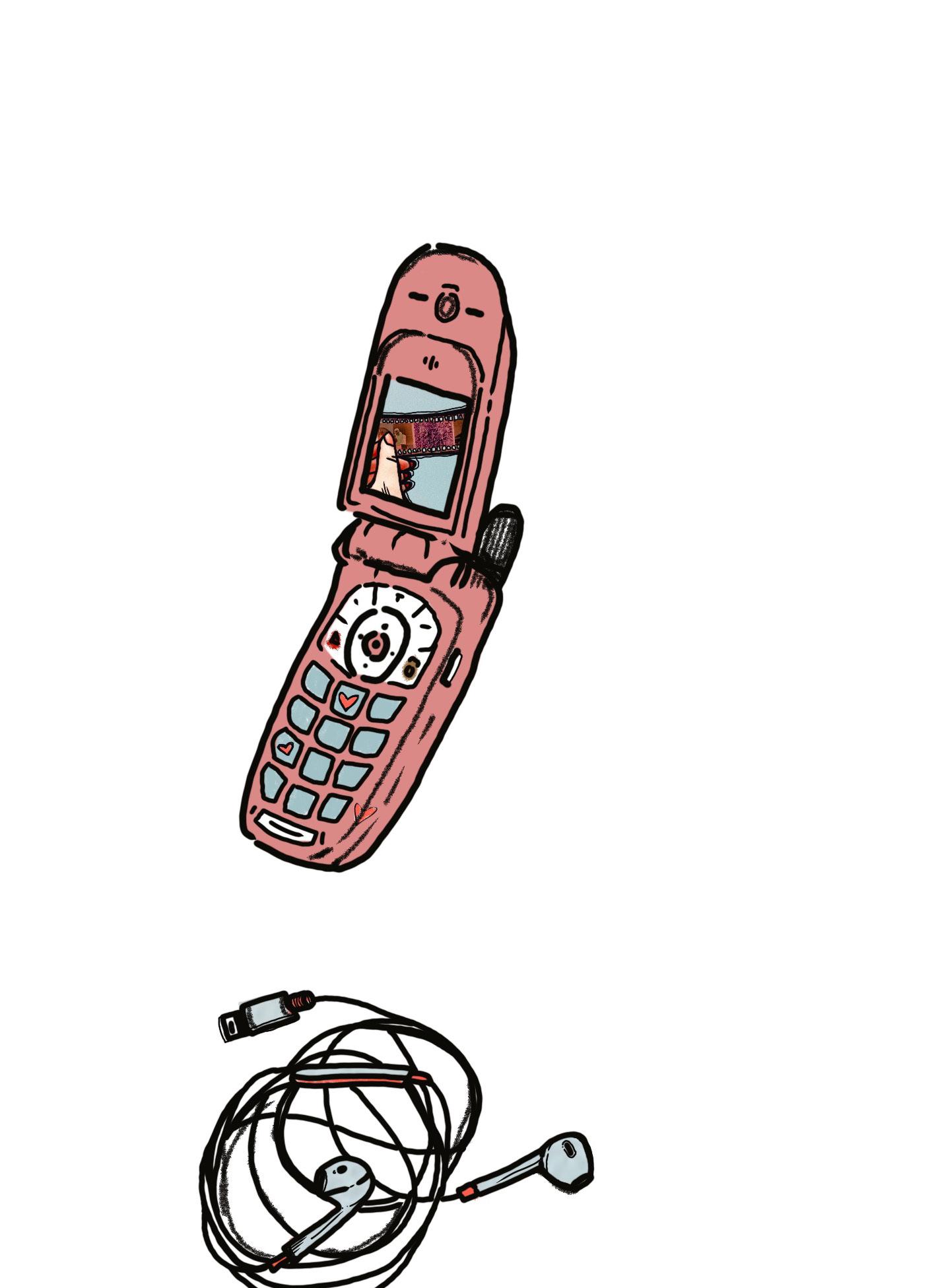
that genuine consequences come from digital overstimulation, including exacerbating feelings of despair. Doom scrolling and social comparisons build an intense pressure, especially for impressionable teenagers logging onto their new phones for the first time. Yet, since so much of our lives revolve around our smartphones, it can be hard to avoid falling further into them in an attempt to resolve any feelings of anxiety. Flip phones offer a away from all of that, and there is also the added benefit that they look cool with low-rise
Beyond reminiscence of the past,


" It makes perfect sense that certain fashion trends have opted away from sleek innovation in favor of the
very deep-rooted anxieties about future development. As we continue accelerating toward some unknown point where artificial intelligence and the metaverse seem synonymous with genuine human connection, it makes perfect sense that certain fashion trends have opted away from sleek innovation in favor of the clunky and the monofunctional. AI technology and social media algorithms that can predict your next thought are developing at an astounding rate. At this point, ChatGPT can essentially do your job or college class for you, all with just a few clicks of the keyboard. While we may not be able to avoid megacorporations consolidating data of our online presence, we can choose to resort to the older technologies that come without these fears, or at least allow us to forget about them for a brief time.
Ultimately, though, the fact that many tech-nostalgia trends emerge and persist on social media is an



irony emblematic of the inability to ever truly escape the influence of the internet. As with all nostalgia, we can’t return to how things used to be, and that discomfort is what propels such a desire for vintage technological styles. In that way, it may seem a little silly to create an Instagram account dedicated to posting the pictures developed from a digital camera, but polaroid and film photography prevails as a recognition of the charms of living a little more in the moment, even if just to curate an artistic feed. I don’t think I’ll ever be able to play my Barbie game again.
Adobe Flash Player, the content that supported most older online games, no longer exists– another technology stuck in time and lost in the acceleration of computers and the internet. But at least I have my record player and wired earbuds, along with all the other reminders that we can use our fashion expression to take a step back and think about life a little more simply, even as the digital age makes it seem impossible.
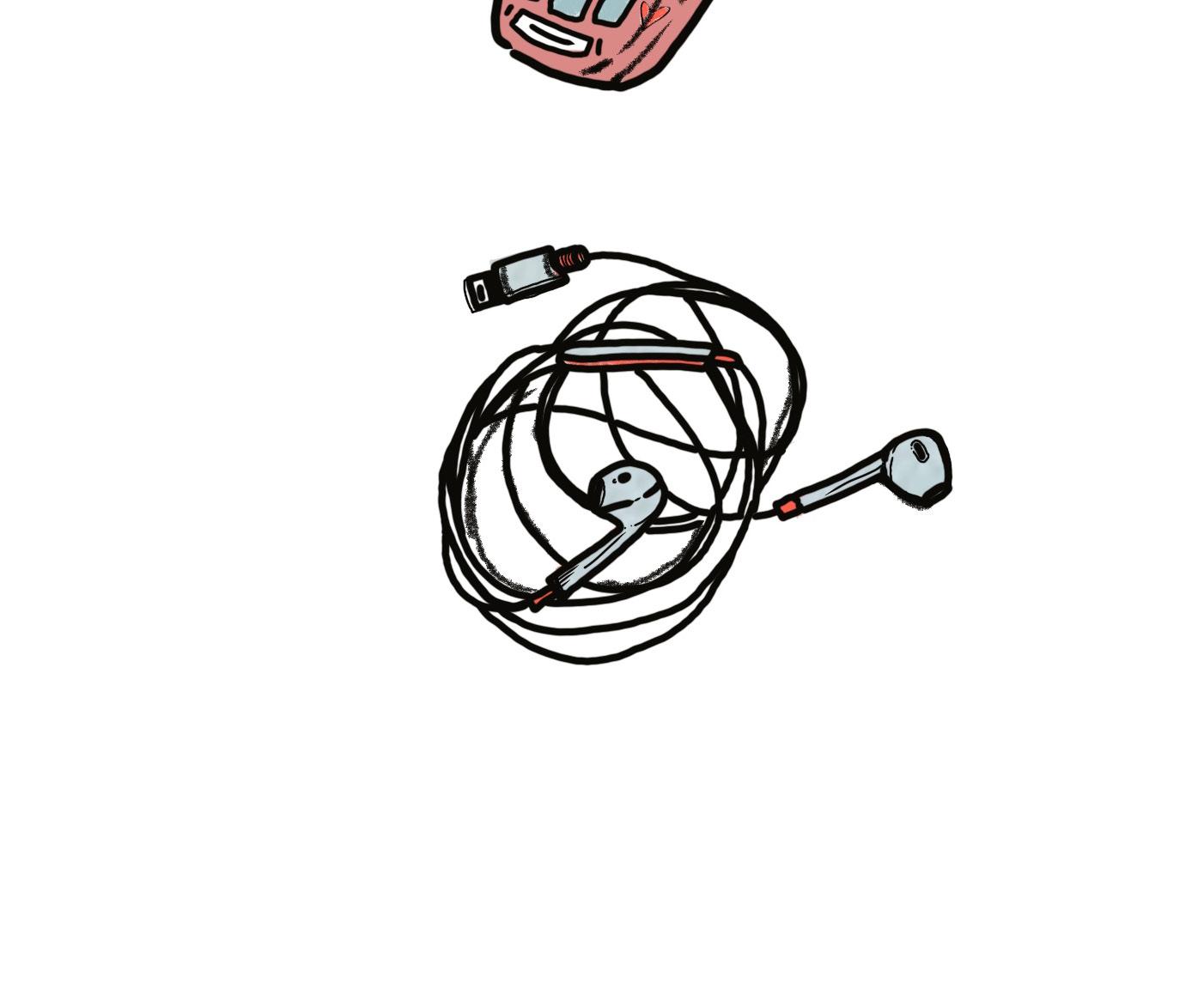
Flip phones offer a way to get away from all of that, and there is also the added benefit that they look cool with lowrise jeans and lace camis.